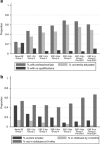Exclusive breastfeeding duration and infant infection
- PMID: 27460268
- PMCID: PMC5153456
- DOI: 10.1038/ejcn.2016.135
Exclusive breastfeeding duration and infant infection
Abstract
Background/objectives: We estimated the risk of infection associated with the duration of exclusive breastfeeding (EBF).
Subject/methods: We analysed the data on 15 809 term, singleton infants from the UK Millennium Cohort Study. Infants were grouped according to months of EBF: never, <2, 2-4, 4-6 and 6 (the latter being World Health Organisation (WHO) policy since 2001: 'post-2001 WHO policy'). Among those EBF for 4-6 months, we separated those who started solids, but not formula, before 6 months, and were still breastfeeding at 6 months (that is, WHO policy before 2001: 'pre-2001 WHO policy'), from other patterns. Outcomes were infection in infancy (chest, diarrhoeal and ear).
Results: EBF was not associated with the ear infection, but was associated with chest infection and diarrhoea. EBF for <4 months was associated with a significantly increased risk of chest infection (adjusted risk ratios (RR) 1.24-1.28) and diarrhoea (adjusted RRs 1.42-1.66) compared with the pre-2001 WHO policy. There was an excess risk of the chest infection (adjusted RR 1.19, 95% confidence interval (CI): 0.97-1.46) and diarrhoea (adjusted RR 1.66, 95% CI: 1.11, 2.47) among infants EBF for 4-6 months, but who stopped breastfeeding by 6 months, compared with the pre-2001 WHO policy. There was no significant difference in the risk of chest infection or diarrhoea in those fed according to the pre-2001 versus post-2001 WHO policy.
Conclusions: There is an increased risk of infection in infants EBF for <4 months or EBF for 4-6 months who stop breastfeeding by 6 months. These results support current guidelines of EBF for either 4-6 or 6 months, with continued breastfeeding thereafter.
Figures


References
-
- World Health Organization The Optimal Duration of Exclusive Breastfeeding: Report of an Expert Consultation. World Health Organization: Geneva, 2001.
-
- Department of Health UK. Infant feeding recommendation, 2003.
-
- Gartner LM, Morton J, Lawrence RA, Naylor AJ, O'Hare D, Schanler RJ et al. Breastfeeding and the use of human milk. Pediatrics 2005; 115: 496–506. - PubMed
MeSH terms
LinkOut - more resources
Full Text Sources
Other Literature Sources
Medical

